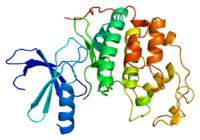
Photo from wikipedia
Cachexia is an involuntary weight loss and muscle wasting that affects up to 80% of advanced cancer patients. It is an independent prognostic marker for response to treatment and overall… Click to show full abstract
Cachexia is an involuntary weight loss and muscle wasting that affects up to 80% of advanced cancer patients. It is an independent prognostic marker for response to treatment and overall survival and accounts for 20% of cancer-associated deaths. Skeletal muscles of cachectic patients manifest metabolic abnormalities, notably increased dependence on lipids as a source of energy at the expense of glucose. Pyruvate Dehydrogenase Kinase 4 (PDK4) is upregulated in the muscles of patients and mice with cancer cachexia. PDK4 inhibits the enzyme responsible for the conversion of pyruvate to acetyl coenzyme A which is further oxidized in the tricarboxylic acid cycle. As a result, lipids become the major substrate for oxidative metabolism at the expense of glucose. Recent reports suggested that PDK4 is responsible for metabolic dysregulation in cachexia, proposing PDK4 as a potential drug target. Here, we hypothesized that the deletion of PDK4 would protect against muscle wasting in an orthotopic model of pancreatic ductal adenocarcinoma (PDAC) by countering metabolic abnormalities driven by PDK4. Methods: 50,000 KPC (LSL-KrasG12D:LSL-Trp53R172H:Pdx1-Cre) cells were injected into the pancreas of male PDK4 knockout mice or wild-type controls. For each genotype, a sham surgery group without implantation was included. Body weight was measured at baseline and later every other day starting from day 7 after implantation. Body composition, i.e., lean and fat mass, was assessed at baseline and then once a week using EchoMRI. In-vivo muscle force production measured by the Aurora Scientific system and locomotor activity measured by Auto-Track were used as readouts of muscle function. Tissue was harvested at early and late stages of disease progression representing early and late cachexia. All measurements were normalized to initial body weight. Two-way ANOVA or Student’s t-test was used for statistical analysis as appropriate. Results: Consistent with previous results, PDAC cachexia induced an increase in the expression of PDK4 in muscle both at mRNA and protein. Expression of other members of the PDK family did not change with cachexia or genotype. Mice with KPC tumors produced less muscle force (-7%, p = 0.03), walked less distance (-30%), and had a longer resting time (17%), p < 0.05 without difference between genotypes. At euthanasia, both genotypes had similar tumor burdens (p >0.9) and exhibited similar degrees of muscle (-13 and -17%, p < 0.0001) and adipose tissue wasting (-50%, p < 0.0001). Deletion of PDK4 did not protect against induction of the muscle-specific E3 ubiquitin ligases in PDAC: FBXO32 and TRIM63 (10.7 fold and 13.6 fold on average, respectively, p < 0.01), molecular hallmarks of muscle atrophy. Overall, our work shows that the knockout of PDK4 does not protect against the development of PDAC cachexia suggesting that PDK4 might be a marker of cachexia but not necessarily a driving mechanism. Citation Format: Omnia U. Gaafer, Joseph Rupert, Joshua Huot, Daenique Jengelley, Andrea Bonetto, Leonidas Koniaris, Teresa Zimmers. PDK4 is dispensable for PDAC chachexia [abstract]. In: Proceedings of the American Association for Cancer Research Annual Meeting 2023; Part 1 (Regular and Invited Abstracts); 2023 Apr 14-19; Orlando, FL. Philadelphia (PA): AACR; Cancer Res 2023;83(7_Suppl):Abstract nr 361.
Journal Title: Cancer Research
Year Published: 2023
Link to full text (if available)
Share on Social Media: Sign Up to like & get
recommendations!